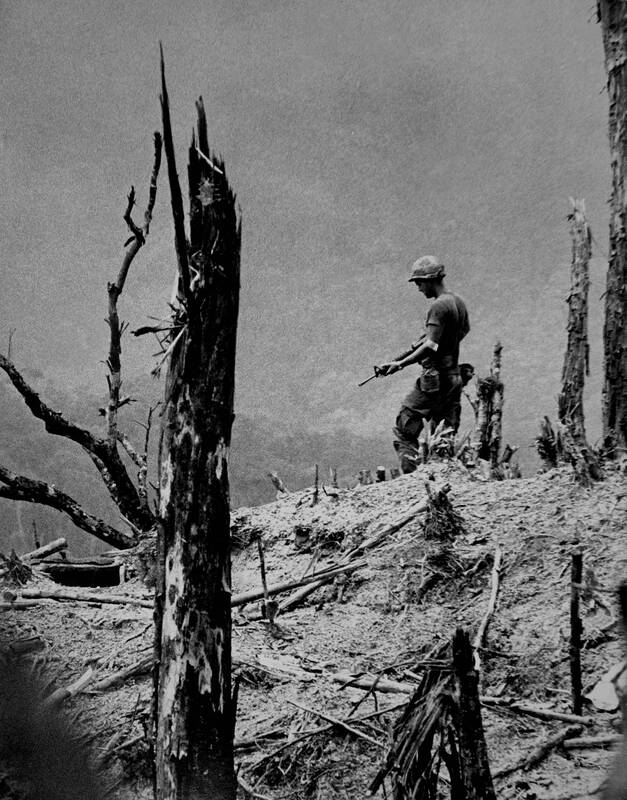"A Different Category Than Most": The diverse experiences of enlisted men in the Vietnam War.
A Dartmouth Vietnam Project Exhibit
Created by Ben Gulihur '24 and Ben Katz '26
What are the nuances of the enlisted experience?
The Vietnam War was complex.
Naturally, stereotypes derived from films, protests, and pop culture have become the fall-back way for us to understand the experiences of the Vietnam veteran. However, the broad strokes which popular culture uses to explain the experiences of American soldiers in Vietnam underestimates the intricacy of the individual. There were 2.6 million Americans who served in military roles in Vietnam, each with their own perspectives and experiences. This exhibit aims to begin to unravel the subtleties of the Vietnam soldier experience, in hopes of adding nuance to the popular understanding of what it means to be a US soldier in Vietnam.
Specifcally, this exhibit focuses on the experiences of enlisted men. Enlisted men were soldiers who did not serve as commissioned or non-commisioned officers during the war. The majority of the military was made up of enlistees. While these soldiers shared a common status, being an non-officer did not automatically lead to having similar experiences to other enlisted soldiers. This exhibit will examine and analyze these nuances from various perspectives.
This exhibit begins by discussing the dichotomy between combat and non-combat personnel, and how many soldiers did not fit cleanly into that dichotomy. The exhibit then turns to the combat experiences of each of our narrators, showing how they differ from the expected experiences of combat and non-combat soldiers. After this, the exhibit will show the mixed experiences that soldiers had coming home from Vietnam. The next page discusses the military awards and honors recieved by our narrators, and how those awards and the narrators' reactions to those awards may not follow what is expected.
Lastly, the exhibit will provide a brief summary of the experiences of our narrators, and links to their interviews and transcripts. We invite you to explore these.
The Narrators
Robert Munson
Robert Munson was born on April 4th, 1947, in Brooklyn New York. He grew up in a military family, and spent much of his childhood bouncing around military bases before eventually settling down with his family in Rhode Island. A strong student in high school, he would make his way to Georgia Tech following his graduation in 1965. After a difficult first year, he left the college and joined the Army, enlisting for 3 years with the Engineering Corps. Following a year of service state-side, Munson would ship off to Vietnam in November of 1967. Due to the chaotic state of the war's administration, the military was not sure where he was supposed to go or who he was, so he became a company clerk. In January of that year, he would be injured in the Tet Offensive, which was a major counter attack launched by the North Vietnamese Army. Munson would go on to serve in support roles across Vietnam, ranging from Cam Ranh Bay to Hue to Khe Sanh. After Vietnam, he would go on to serve another year state-side at Fort Belvoir, before transitioning back to civilian life.
Tony Thompson
Tony Thompson, Dartmouth class of 1964, enlisted as a Radioman in 1963 taking a hiatus from college at the recommendation of his dean. He went to Vietnam during the advisory period in 1964. The first 6 months he spent rotating in and out of Aloui and Tabat in the A Shau valley. In the latter half of his deployment he was attached to the decorated ARVN 1st regiment at the DMZ and saw their destruction in March of 1965. He earned Bronze Star and Vietnam Cross of Gallantry for his service. Tony returned to Dartmouth 3 months later and had a poor experience with anti-war sentiment. The aggressive anti-war environment made him move off campus to finish his degree. He left the U.S. for the less hostile environment of Australia but returned to Vermont in the 90’s.
This exhibit is dedicated to Robert Munson and Tony Thompson '64, whose interviews were invaluable to the creation of this exhibit.
Navigating this Exhibit
This exhibit contains 7 pages, including this home page. These pages may be viewed in any order, although we recommend viewing it in the order shown below. Click on any of the links below to go to that page.




